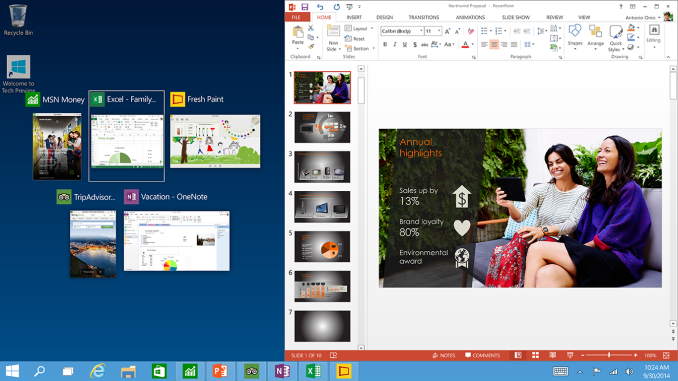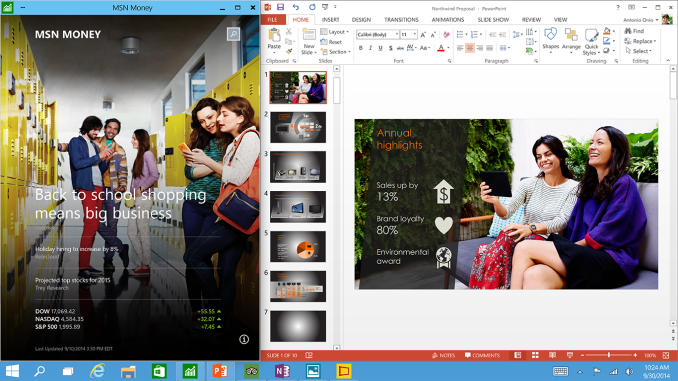Windows 10 Technical Preview First Impressions: The Return Of The Desktop
by Brett Howse on November 13, 2014 8:00 AM EST- Posted in
- Software
- Microsoft
- Windows 10
Closing Thoughts
If Windows 8 was “Touch First” then clearly Windows 10 is not. The current technical preview is very much geared towards the traditional mouse and keyboard user. This will change of course over the next several months, as the touch features get integrated back into Windows 10. As a user of all types of Windows devices, I welcome this change. It allows me to be more productive on my desktop, but still use the touch based Start Screen on a tablet or convertible notebook. Some good things have been done here to hopefully embrace the current user base, as well as new device types.
There are a number of features aimed squarely at businesses. If Microsoft wants to avoid another Windows XP with Windows 7 – where businesses do not migrate until they absolutely have to – then these features are certainly a carrot that may entice them to at least try it out. The Start Menu and other desktop additions will be great for the business users, and I think the IT crowd will be happy with a lot of the new additions around device management, identity management, and information management.
This is a technical preview of course, but still I would be remiss to not mention that it is not without its bugs. I have had a lot of issues with Windows Store apps, with many of them crashing especially when they are not the active window. Possibly there are some changes to the underlying WinRT framework for apps in standby but until we hear more about the framework changes then these problems will likely continue. More of this information should come out around the time of the next BUILD conference, scheduled for April 29th to May 1st 2015. Other issues with WinRT apps currently is that even though they can be used in a window, the absolute height of the window is limited. When Windows 8 was launched, WinRT apps were expecting to be either full screen, or snapped to the side. As such, the apps in a window must maintain a minimum height. Hopefully this can get sorted out in the future.
At first glance, Windows 10 looks like Windows 8 with a Start Menu. It is clearly a lot more than that, but even so, as someone very smart told me, that’s not a bad thing. Windows 8 had a lot going for it, but design decisions were made early on, and with a “my way or no way” attitude that it was difficult to use. It seems that Windows 10 really addresses a lot of this, while at the same time keeping and expanding on a lot of the great features that were in Windows 8 and likely overlooked due to a lot of animosity towards it.
The Windows Store is going to be a big part of this, and if the rumors of desktop apps being integrated into the store is true, then the OOBE for Windows 10 will be amazing. All of your settings and apps will now follow you from device to device, with a single log in. A lot of that is already there with Windows 8, but 10 should finish off the last remaining pieces if this is true. It makes a lot of sense, so unless the licensing terms are awful, this could be a fantastic addition to the store.
The Universal App model is also a big piece of the puzzle, but here there is more work to do. WinRT has a lot of advantages, but the framework needs to be updated at a rapid pace in order to draw developers in. It is somewhat seductive to be able to target desktops, laptops, tablets, phones, and the TV with Xbox One with a single application (with multiple interfaces of course) but until the framework is made powerful enough for more apps than just simple web front ends, it may be difficult to realize this idea. Once again, more info should be available at BUILD in regards to this.
I’ve also had some bugginess with the WinRT apps on Windows 8, which I hope will be fixed with Windows 10. At this point though, the WinRT apps are even buggier so likely there will be more pain before this is all corrected.
Although we have only seen the Technical Preview and a single update to it so far, you can see the potential for Windows 10 and what it will be able to accomplish. It is an ambitious goal to provide a single platform across such a swath of different devices, and one that was held back by the user interface before. With Continuum, it appears that it may be the best of both worlds. Even more exciting is how much more upfront and open Microsoft has been on this entire process, with not just the technical preview but also soliciting and requesting user feedback on the changes. One of the biggest change requests was a simple animation on the Start Menu, and that has already been implemented, so this really is a different world than when Windows 8 was given a sneak peek.
Due to the timing of the latest release that just came out, this article is based on the second build of Windows 10 and I have not had a chance to go over any of the changes in the latest built that arrived on November 12th.
Going forward, as we get more updates to the preview we will do our best to keep you fully informed with that the changes are, and how they will affect you. If you want to kick the tires of Windows 10 and you have not yet, just visit http://preview.windows.com and sign up for the technical preview.












198 Comments
View All Comments
inighthawki - Friday, November 14, 2014 - link
I have to disagree. The trend clearly began as a way to improve load times on low and limited bandwidth connections by removing a lot of the glam and gloss and relying more on CSS style sheets to expose a minimalist design. The problem is that this turned into a really awful fad of "Me too!" design philosophies and now everyone is trying to fit it in everywhere, just because it worked out in its original incarnation. Flat design works EXTREMELY well, in select cases. An operating system can have multiple uses. On a phone and a tablet, these goals are content consumption - e.g. web browsing, photos, videos, etc. On a desktop, an OS is more of a tool for productivity purposes. Flat design does NOT work well here. It may satisfy some hipster craze for their OS to look "modern" and that might be fine as they use their computers to go browse facebook and post to twitter. But this design is extremely counter productive for power users, since it strips all of the design cues that are there to empower the user, such as high contrasting window borders. skeumorphism design mimics real-world designs for a reason. The real world is an extremely productive environment that humans are familiar with. Giving humans tools in an environment that is recognizable enhances productivity. Having a window frame that appears to be made of real-world materials such as wood, glass, etc, with 3D effects that mimic depth work way better than solid colors with light accents for multitasking.I'm fine with metro on my phone and on my tablet. But on the desktop - it needs to die. This goes not just for windows, but for Office and Visual Studio as well. All the latest versions of each are easily the worst versions Microsoft has ever released.
sphigel - Thursday, November 13, 2014 - link
I used to think the same thing. When I upgraded to Windows 8 and Office 2013 I really hated the look of it. After using it a while, I now think that Windows 7 and Office 2010 are ugly looking. Having said that, I'm really looking forward to the drop shadows on windows coming back in Windows 10. They did go a little too flat with the UI in Windows 8.kmmatney - Thursday, November 13, 2014 - link
I have teh opposite reaction. I use win 8 at work and for my home computer, but also have a few Windows 7 computers at home. Whenever I go on a Windows 7 computer, the first thing that jumps out at me is how much nicer it looks compared to Windows 8.steven75 - Friday, November 14, 2014 - link
Same experience. I also have used Office 2013 for a while, and even in the farsical "dark theme" that is a very very lightly shaded gray, I still HATE the white-everywhere with no contrast look of it.GuardianAngel470 - Saturday, November 15, 2014 - link
I've been using Office 2013 for a while now. I like it, but then I've never really used Office with a Dark theme so, even though "Dark" is light grey, it doesn't really bother me.However, for anyone who does use Dark for anything, I sympathize completely.
andrewaggb - Sunday, November 16, 2014 - link
Yeah the windows 8 color scheme has grown on me as well. Not a big fan of IOS 8's theme.I don't use the start screen at all on the desktop, but I love it on my miix tablet. Definitely was a mistake to try to force it on the desktop, but I think everyone except microsoft knew that. And probably many people there did as well.
jabber - Friday, November 14, 2014 - link
For me what was wrong for Windows 8 was the use of purple on the desktop in so much of the media advertising. Looks wrong.Who likes Purple? Notice that Windows 10 now uses far more neutral blue.
Da W - Thursday, November 13, 2014 - link
9.0/10 for Windows 10 so far.The thing i miss i that i don't clik the start button to see some of my live tiles as often now. Some tiles (facebook, mail, calendar, weater) are useful. They should make them like widget on your desktop (yes bring back the widgets).
Houdani - Thursday, November 13, 2014 - link
Rather than widgets, I'd be happy if they would let us snap a "start screen" to one side of the monitor so we could fill it with a selection of live tiles.croc - Friday, November 14, 2014 - link
"That is what is going to make or break this version for mainstream users (who by in large like win8.1)" I'd have a hard time calling 11% 'mainstream'.http://www.netmarketshare.com/operating-system-mar...